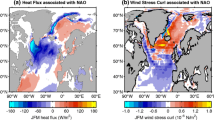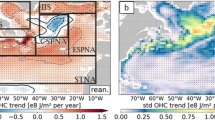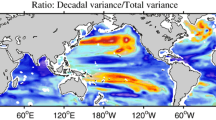Abstract
Observations show a multidecadal signal in the North Atlantic ocean, but the underlying mechanism and cause of its timescale remain unknown. Previous studies have suggested that it may be driven by the North Atlantic Oscillation (NAO), which is the dominant pattern of winter atmospheric variability. To further address this issue, the global ocean general circulation model, Nucleus for European Modelling of the Ocean (NEMO), is driven using a 2,000 years long white noise forcing associated with the NAO. Focusing on key ocean circulation patterns, we show that the Atlantic Meridional Overturning Circulation (AMOC) and Sub-polar gyre (SPG) strength both have enhanced power at low frequencies but no dominant timescale, and thus provide no evidence for a oscillatory ocean-only mode of variability. Instead, both indices respond linearly to the NAO forcing, but with different response times. The variability of the AMOC at 30°N is strongly enhanced on timescales longer than 90 years, while that of the SPG strength starts increasing at 15 years. The different response characteristics are confirmed by constructing simple statistical models that show AMOC and SPG variability can be related to the NAO variability of the previous 53 and 10 winters, respectively. Alternatively, the AMOC and the SPG strength can be reconstructed with Auto-regressive (AR) models of order seven and five, respectively. Both statistical models reconstruct interannual and multidecadal AMOC variability well, while on the other hand, the AR(5) reconstruction of the SPG strength only captures multidecadal variability. Using these methods to reconstruct ocean variables can be useful for prediction and model intercomparision.












Similar content being viewed by others
Notes
The station based NAO index of Jones et al. (1997) is not ideal for the summer since the centers of action of the NAO are shifted to be centered over Greenland and the United Kingdom, as opposed to Iceland and the Azores, based on an EOF analysis (Hurrell et al. 2003; Greatbatch and Rong 2006). We ignore this issue here since it is the winter NAO that matters for forcing the AMOC (Eden and Willebrand 2001).
Here, and in what follows, inter-annual refers to unfiltered data and decadal to data following the application of an 11 years running mean.
A simple red spectrum is defined in Gilman et al. (1963) to be a first order Auto-Regressive process, AR(1), process.
References
Ba J, Keenlyside NS, Park W, Latif M, Hawkins E, Ding H (2013) A mechanism for Atlantic multidecadal variability in the Kiel Climate Model. Clim Dyn pp 1–12. doi:10.1007/s00382-012-1633-4
Barnier B, Madec G, Penduff T, Molines J, Treguier A, Le Sommer J, Beckmann A, Biastoch A, Böning C, Dengg J et al (2006) Impact of partial steps and momentum advection schemes in a global ocean circulation model at eddy-permitting resolution. Ocean Dyn 56(5):543–567. doi:10.1007/s10236-006-0082-1
Barnston A, Livezey R (1987) Classification, seasonality and persistence of low-frequency atmospheric circulation patterns. Mon Weather Rev 115(6):1083–1126
Bjerknes J (1964) Atlantic air-sea interaction. Adv Geophys 10(1):1–82
Born A, Mignot J (2012) Dynamics of decadal variability in the atlantic subpolar gyre: a stochastically forced oscillator. Clim Dyn 39(1):461–474. doi:10.1007/s00382-011-1180-4
Chylek P, Folland C, Dijkstra H, Lesins G, Dubey M (2011) Ice-core data evidence for a prominent near 20 year time-scale of the Atlantic Multidecadal Oscillation. Geophys Res Lett 38(13):L13,704. doi:10.1029/2011GL047501
Curry R, McCartney M (2001) Ocean gyre circulation changes associated with the North Atlantic Oscillation. J Phys Oceanogr 31(12):3374–3400
Delworth T, Greatbatch R (2000) Multidecadal thermohaline circulation variability driven by atmospheric surface flux forcing. J Clim 13(9):1481–1495
Delworth T, Zeng F (2012) Multicentennial variability of the Atlantic meridional overturning circulation and its climatic influence in a 4000 year simulation of the GFDL CM2. 1 climate model. Geophys Res Lett 39(13):L13,702. doi:10.1029/2012GL052107
Delworth T, Manabe S, Stouffer R (1993) Interdecadal variations of the thermohaline circulation in a coupled ocean-atmosphere model. J Clim 6(11):1993–2011
Dickson R, Lazier J, Meincke J, Rhines P, Swift J (1996) Long-term coordinated changes in the convective activity of the North Atlantic. Prog Oceanogr 38(3):241–295
Dickson R, Osborn T, Hurrell J, Meincke J, Blindheim J, Adlandsvik B, Vinje T, Alekseev G, Maslowski W (2000) The Arctic Ocean response to the North Atlantic Oscillation. J Clim 13(15):2671–2696. doi:10.1175/1520-0442(2000)013<2671:TAORTT>2.0.CO;2
Dijkstra H, Te Raa L, Schmeits M, Gerrits J (2006) On the physics of the Atlantic Multidecadal Oscillation. Ocean Dyn 56(1):36–50. doi:10.1007/s10236-005-0043-0
Dima M, Lohmann G (2007) A hemispheric mechanism for the Atlantic Multidecadal Oscillation. J Clim 20(11):2706–2719. doi:10.1175/JCLI4174.1
Drinkwater K, Belgrano A, Borja A, Conversi A, Edwards M, Greene C, Ottersen G, Pershing A, Walker H (2003) The response of marine ecosystems to climate variability associated with the North Atlantic Oscillation. Geophys Monogr Am Geophys Union 134:211–234
Eden C, Jung T (2001) North atlantic interdecadal variability: oceanic response to the North Atlantic Oscillation (1865-1997). J Clim 14(5):676–691.doi:10.1175/1520-0442(2001)014<0676:NAIVOR>2.0.CO;2
Eden C, Willebrand J (2001) Mechanism of interannual to decadal variability of the North Atlantic circulation. J Clim 14(10):2266–2280. doi:10.1175/1520-0442(2001)014<2266:MOITDV>2.0.CO;2
Eden C, Greatbatch R, Lu J (2002) Prospects for decadal prediction of the North Atlantic Oscillation (NAO). Geophys Res Lett 29(10):1466. doi:10.1029/2001GL014069
Enfield D, Mestas-Nunez A, Trimble P et al (2001) The atlantic multidecadal oscillation and its relation to rainfall and river flows in the continental US. Geophys Res Lett 28(10):2077–2080. doi:10.1029/2000GL012745
Gaspar P, Grégoris Y, Lefevre JM (1990) A simple eddy kinetic energy model for simulations of the oceanic vertical mixing: Tests at station Papa and Long-Term Upper Ocean Study site. J Geophys Res Oceans (1978–2012) 95(C9):16179–16193. doi:10.1029/JC095iC09p16179
Gent P, McWilliams J (1990) Isopycnal mixing in ocean circulation models. J Phys Oceanogr 20(1):150–155. doi:10.1029/2004GL019932
Gilman D, Fuglister F, Mitchell Jr J (1963) On the power spectrum of red noise. J Atmos Sci 20(2):182–184
Goldenberg S, Landsea C, Mestas-Nuñez A, Gray W (2001) The recent increase in Atlantic hurricane activity: Causes and implications. Science 293(5529):474–479.doi:10.1126/science.1060040
Gray S, Graumlich L, Betancourt J, Pederson G (2004) A tree-ring based reconstruction of the Atlantic Multidecadal Oscillation since 1567 AD. Geophys Res Lett 31(12):L12205. doi:10.1029/2004GL019932
Greatbatch R (2000) The North Atlantic Oscillation. Stoch Environ Res Risk Assess 14(4):213–242. doi:10.1007/s004770000047
Greatbatch R, Rong P (2006) Discrepancies between different Northern Hemisphere summer atmospheric data products. J Clim 19(7):1261–1273
Greatbatch R, Zhang S (1995) An interdecadal oscillation in an idealized ocean basin forced by constant heat flux. J Clim 8(1):81–91
Griffies S, Tziperman E (1995) A linear thermohaline oscillator driven by stochastic atmospheric forcing. J Clim 8(10):2440–2453. doi:10.1175/1520-0442(1995)008<2440:ALTODB>2.0.CO;2
Griffies S, Winton M, Samuels B (2004) The Large and Yeager dataset and CORE. NOAA Geophysical Fluid Dynamics Laboratory PO Box 308, Princeton, New Jersey
Griffies S, Biastoch A, Böning C, Bryan F, Danabasoglu G, Chassignet E, England M, Gerdes R, Haak H, Hallberg R et al (2009) Coordinated ocean-ice reference experiments (COREs). Ocean Model 26(1):1–46. doi:10.1016/j.ocemod.2008.08.007
Gulev SK, Jung T, Ruprecht E (2002) Climatology and interannual variability in the intensity of synoptic-scale processes in the north atlantic from the ncep-ncar reanalysis data. J Clim 15(8):809–828. doi:10.1175/1520-0442(2002)015<0809:CAIVIT>2.0.CO;2
Hasselmann K (1976) Stochastic climate models. Tellus 28(6):31–762,896
Hetzinger S, Halfar J, Mecking J, Keenlyside N, Kronz A, Steneck R, Adey W, Lebednik P (2012) Marine proxy evidence linking decadal north pacific and atlantic climate. Clim Dyn 39(6):1447–1455. doi:10.1007/s00382-011-1229-4
Hurrell J (1995) Decadal trends in the north atlantic oscillation: regional temperatures and precipitation. Science 269(5224):676–678. doi:10.1126/science.269.5224.676
Hurrell J (1996) Influence of variations in extratropical wintertime teleconnections on northern hemisphere temperature. Geophys Res Lett 23(6):665–668
Hurrell J, Kushnir Y, Ottersen G, Visbeck M (2003) The North Atlantic Oscillation: climatic significance and environmental impact, vol 134. American Geophysical Union, Washington, DC
Jones P, Jonsson T, Wheeler D (1997) Extension to the north atlantic oscillation using early instrumental pressure observations from gibraltar and south-west iceland. Int J Climatol 17(13):1433–1450
Jungclaus J, Haak H, Latif M, Mikolajewicz U (2005) Arctic-North Atlantic interactions and multidecadal variability of the meridional overturning circulation. J Clim 18(19):4013–4031. doi:10.1175/JCLI3462.1
Kerr R (2000) A north atlantic climate pacemaker for the centuries. Science 288(5473):1984–1985. doi:10.1126/science.288.5473.1984
Kilbourne K, Quinn T, Webb R, Guilderson T, Nyberg J, Winter A (2008) Paleoclimate proxy perspective on caribbean climate since the year 1751: evidence of cooler temperatures and multidecadal variability. Paleoceanography 23(3):PA3220. doi:10.1029/2008PA001598
Knight J, Allan R, Folland C, Vellinga M, Mann M (2005) A signature of persistent natural thermohaline circulation cycles in observed climate. Geophys Res Lett 32(20):2–5. doi:10.1029/2005GL024233
Köller M, Käse R, Herrmann P (2010) Interannual to multidecadal variability and predictability of North Atlantic circulation in a coupled earth system model with parametrized hydraulics. Tellus A 62(4):569–578. doi:10.1111/j.1600-0870.2010.00450.x
Kwon Y, Frankignoul C (2012) Stochastically-driven multidecadal variability of the Atlantic meridional overturning circulation in CCSM3. Clim Dyn 38(5):859–876. doi:10.1007/s00382-011-1040-2
Langehaug H, Medhaug I, Eldevik T, Otterå O (2012) Arctic/Atlantic exchanges via the subpolar gyre. J Clim. 25(7):2421–2439. doi:10.1175/JCLI-D-11-00085.1
Large W, Yeager S (2004) Diurnal to decadal global forcing for ocean and sea-ice models: the data sets and flux climatologies. NCAR Technical Note: NCAR/TN-460+STR. CGD Division of the National Center for Atmospheric Research. doi:10.5065/D6KK98Q6
Large W, Yeager S (2009) The global climatology of an interannually varying air–sea flux data set. Clim Dyn 33(2):341–364. doi:10.1007/s00382-008-0441-3
Latif M, Böning C, Willebrand J, Biastoch A, Dengg J, Keenlyside N, Schweckendiek U, Madec G (2006) Is the thermohaline circulation changing? J Clim 19(18):4631–4637. doi:10.1175/JCLI3876.1
Lohmann K, Drange H, Bentsen M (2009) A possible mechanism for the strong weakening of the North Atlantic subpolar gyre in the mid-1990s. Geophys Res Lett 36(15):L15,602. doi:10.1029/2009GL039166
Madec G, Delecluse P, Imbard M, Lévy C et al (1998) Opa 8.1 ocean general circulation model reference manual. Note du Pôle de modélisation, Institut Pierre-Simon Laplace 11
Marshall J, Schott F (1999) Open-ocean convection: Observations, theory, and models. Rev Geophy 37(1):1–64. doi:10.1029/98RG02739
Medhaug I, Langehaug H, Eldevik T, Furevik T, Bentsen M (2012) Mechanisms for decadal scale variability in a simulated Atlantic meridional overturning circulation. Clim Dyn 39(1–2):77–93. doi:10.1007/s00382-011-1124-z
Menary M, Park W, Lohmann K, Vellinga M, Palmer M, Latif M, Jungclaus J (2012) A multimodel comparison of centennial Atlantic meridional overturning circulation variability. Clim Dyn 38(11):2377–2388. doi:10.1007/s00382-011-1172-4
Msadek R, Frankignoul C (2009) Atlantic multidecadal oceanic variability and its influence on the atmosphere in a climate model. Clim Dyn 33(1):45–62. doi:10.1007/s00382-008-0452-0
Ortega P, Hawkins E, Sutton R (2011) Processes governing the predictability of the Atlantic meridional overturning circulation in a coupled gcm. Clim Dyn 37(9):1771–1782. doi:10.1007/s00382-011-1025-1
Park W, Latif M (2011) Atlantic meridional overturning circulation response to idealized external forcing. Clim Dyn 39(7–8):1709–1726. doi:10.1007/s00382-011-1212-0
Rayner N, Parker D, Horton E, Folland C, Alexander L, Rowell D, Kent E, Kaplan A (2003) Global analyses of sea surface temperature, sea ice, and night marine air temperature since the late nineteenth century. J Geophys Res 108(D14):4407. doi:10.1029/2002JD002670
Schweckendiek U, Willebrand J (2005) Mechanisms affecting the overturning response in global warming simulations. J Clim 18(23):4925–4936. doi:10.1175/JCLI3550.1
Shumway RH, Stoffer DS, Stoffer DS (2000) Time series analysis and its applications, vol 549. Springer, New York
Skeie P (2000) Meridional flow variability over the Nordic seas in the Arctic Oscillation framework. Geophys Res Lett 27(16):2569–2572. doi:10.1029/2000GL011529
The Drakkar Group (2007) Eddy-permitting ocean circulation hindcasts of past decades. Clivar Exch (12):8–10
Timmermann A, Latif M, Voss R, Grötzner A (1998) Northern hemispheric interdecadal variability: a coupled air-sea mode. J Clim 11(8):1906–1931
Torrence C, Compo G (1998) A practical guide to wavelet analysis. Bull Am Meteorol Soc 79(1):61–78
Vellinga M, Wu P (2004) Low-latitude freshwater influence on centennial variability of the atlantic thermohaline circulation. J Clim 17(23):4498–4511. doi:10.1175/3219.1
Visbeck M, Cullen H, Krahmann G, Naik N (1998) Ocean model’s response to north atlantic oscillation-like wind forcing. Geophys Res Lett 25(24):4521–4524
Visbeck M, Chassignet E, Curry R, Delworth T, Dickson R, Krahmann G (2003) The ocean’s response to north atlantic oscillation variability. Geophys Monogr Am Geophys Union 134:113–146
Von Storch H, Zwiers FW (2002) Statistical analysis in climate research. Cambridge University Press, Cambridge
Wunsch C (1999) The interpretation of short climate records, with comments on the north atlantic and southern oscillations. Bull Am Meteorol Soc 80:245–256. doi:10.1175/1520-0477(1999)080<0245:TIOSCR>2.0.CO;2
Zhang R (2007) Anticorrelated multidecadal variations between surface and subsurface tropical north atlantic. Geophys Res Lett 34(12):L12,713. doi:10.1029/2007GL030225
Zhang R, Delworth T (2006) Impact of atlantic multidecadal oscillations on india/sahel rainfall and atlantic hurricanes. Geophys Res Lett 33(17):L17,712. doi:10.1029/2006GL026267
Acknowledgments
We thank to two anonymous reviewers, and Mojib Latif for their helpful comments. The work was primarily supported by the Deutsches Forschungsgemeinschaft under the Emmy Noether Programm (Grant KE 1471/2-1). We would also acknowledge support from GEOMAR, the EU-THOR (No. GA212643) and EU-STEPS (PCIG10-GA-2011-304243) projects, and the Norddeutscher Verbund für Hoch- und Höchstleistungsrechnen (HLRN) computing facility. GEOMAR TM Group and DRAKKAR consortium provided support with various modelling aspects.
Author information
Authors and Affiliations
Corresponding author
Appendix: Auto-regressive processes
Appendix: Auto-regressive processes
Following chapter 3 in Shumway et al. (2000), an auto-regressive (AR) processes uses values from past time steps to compute the current time step, as shown in Eq. 2. To determine the order, q, of the AR process the partial auto-correlation function (PACF) is computed. The PACF at lag k is the correlation between x t with x t+k with the dependence on x t+1 to x t+k−1 removed from both x t with x t+k . The partial autocorrelation can be computed using the Durbin-Levinson iterative algorithm detailed in Shumway et al. (2000). The last lag at which the PACF is significant at the 5 % level is the order, q, which is for the best fit for the AR process. In contrast to the AR process the best fit for a weighted moving average process (like the integrated NAO used in this study) can be determined in the same way from the auto-correlation function. The coefficients for the AR process are calculated using the Yule-Walker equations (detailed in Shumway et al. 2000) and a theoretical spectrum can be constructed using the following equation from Von Storch and Zwiers (2002):
where, ω is the frequency and σ 2 is the variance for the time-series x(t).
Rights and permissions
About this article
Cite this article
Mecking, J.V., Keenlyside, N.S. & Greatbatch, R.J. Stochastically-forced multidecadal variability in the North Atlantic: a model study. Clim Dyn 43, 271–288 (2014). https://doi.org/10.1007/s00382-013-1930-6
Received:
Accepted:
Published:
Issue Date:
DOI: https://doi.org/10.1007/s00382-013-1930-6




